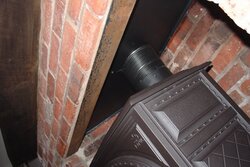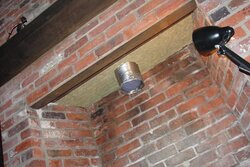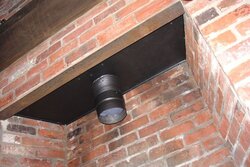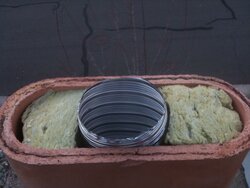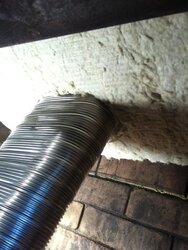Hi, hoping someone can help resolve a question I've had for a while. I recently installed a 316Ti liner in my chimney for my wood stove. The stove sits in front of the fireplace and the piping runs through the damper plate opening and up the length of the chimney, about 20 feet. At the top I have a plate covering the flue with a cap on top . I packed some unfaced fiberglass insulation around the liner just under the plate at the top of the chimney. I was told by a local chimney sweep that this was acceptable. However, I have read elsewhere online that mineral wool or other such insulation should be used near the pipe. Anyone have experience with this? Thanks for any help.
Insulation around chimney liner?
- Thread starter davis817
- Start date
-
Active since 1995, Hearth.com is THE place on the internet for free information and advice about wood stoves, pellet stoves and other energy saving equipment.
We strive to provide opinions, articles, discussions and history related to Hearth Products and in a more general sense, energy issues.
We promote the EFFICIENT, RESPONSIBLE, CLEAN and SAFE use of all fuels, whether renewable or fossil.
You are using an out of date browser. It may not display this or other websites correctly.
You should upgrade or use an alternative browser.
You should upgrade or use an alternative browser.
- Status
- Not open for further replies.
cycloxer
Minister of Fire
Mineral wool is better as it does not burn and has a very high melting temperature. Fiberglass does not burn either, but it does melt at a lower temperature. So, it is not necessarily the right way to do it, but it also isn't going to burn down your house.
derecskey
New Member
You know, I was just going to post a related question about proper liner, etc. installation, less the insulation. I have a small insert in my masonry fireplace opening, with an insert surround. I did not self-install, rather I had the stove installed for me. When my stove gets going good, the insert surround plate actually warps slightly from the heat and pulls away from the sandstone fireplace. (My stove is a rather cheapish Buck 21, and I know the surround plate is not all that thick).
So the gap there got me thinking... what if I just took the insert surround off and had a hearth stove installation, like yours? But is there a plate blocking the flue where the damper once was? My setup is just like yours. Damper plate removed, flexible liner installed, plate siliconed to top of flue with cap on top. But there's nothing blocking the flue where the damper plate used to be. Should there be?
So I did the match test. I lit a match, blew it out, and held it near the opening gap between the insert surround and the masonry and sure enough it really sucked the smoke (and even the flame from the second match I tried) right up the flue. Is this just the convection of the heat? Or am I leaking all my heat out right up the flue between the flue and the liner? Is my insert and liner installed properly?
So the gap there got me thinking... what if I just took the insert surround off and had a hearth stove installation, like yours? But is there a plate blocking the flue where the damper once was? My setup is just like yours. Damper plate removed, flexible liner installed, plate siliconed to top of flue with cap on top. But there's nothing blocking the flue where the damper plate used to be. Should there be?
So I did the match test. I lit a match, blew it out, and held it near the opening gap between the insert surround and the masonry and sure enough it really sucked the smoke (and even the flame from the second match I tried) right up the flue. Is this just the convection of the heat? Or am I leaking all my heat out right up the flue between the flue and the liner? Is my insert and liner installed properly?
I used to have a 5' section of ovalized pipe that went throught the damper opening (damper plate removed) and up the chimney a few feet. At that time I had a blocker plate on the damper opening with a hole for the pipe to pass through. Never did seal it well though and had drafts when not using the stove. I went with the liner for better stove draft and am guessing the plate at the top of the flue provides some protection against a draft. I thought packing insulation either at the top or bottom would help with any remaining draft. I went with insulation at the top thinking that any warm air from the house would make it part way up the chimney and help keep the liner warm since I didn't insulate the liner.
cycloxer
Minister of Fire
Seal, insulate, and block off both the top and the bottom with metal and a fireproof insulator for best results. Here is my lower block off plate.
Attachments
oconnor
Minister of Fire
Fibreglass insulation is definately the wrong stuff to use, and most mineral wool batts actually aren't rated to the 2100*F temps that purpose built flue products need to be tested to. If you want to insulate around a flue, I recommend you use the products that your liner manufacturer approves of in the instructions for your liner - most will refer to a ceramic fibre blanket, 1/2" thick.
davis817 said:Hi, hoping someone can help resolve a question I've had for a while. I recently installed a 316Ti liner in my chimney for my wood stove. The stove sits in front of the fireplace and the piping runs through the damper plate opening and up the length of the chimney, about 20 feet. At the top I have a plate covering the flue with a cap on top . I packed some unfaced fiberglass insulation around the liner just under the plate at the top of the chimney. I was told by a local chimney sweep that this was acceptable. However, I have read elsewhere online that mineral wool or other such insulation should be used near the pipe. Anyone have experience with this? Thanks for any help.
You will get answers both ways on this one.
I, for one, agree with your chimney sweep.
I installed wood burning inserts (& stoves) for 5 years before
moving to the sales floor & EVERY one of them - in a masonru fire place -
is installed with unfaced fiberglass insulation
both UNDER the cap & in the damper area.
NOT ONCE has there been an issue with ANY of these installs.
Fiberglass does not melt. It does not outgas. It works, period.
I pulled my 3100L out of my fire place after 4 years of burning it
as a primary heat source - 4 -5 cords per year - & the fiberglass looked
& felt EXACTLY the same as the day I installed it.
It was NOT melted. It was NOT discolored. It was NOT deteriorated
in ANY way.
We can battle this all we want & folks here will continue to disagree,
so you can take what you want from both sides of the argument.
I've worked for this company for 9+ years, & the owner started the business
in 1977 in his garage. He is one of the more respected voices in the field of
wood burning & in fact his input is directly felt by anyone here who has taken the
NFI Certification Exam for wood burning. He is part of the board assembled to
develop the questions & answers, & under HIS direction,
we install with unfaced fiberglass, because it's safe to use
& it works very well...
cycloxer
Minister of Fire
In your own house you can use whatever you want. The key is to stay away from combustible materials. If you are going to use a board, watch out for those with paper foil backings. I almost built one out of that stuff and the problem is that the foil can burn as it is paper based and adhered with tar.
Most insulations in and of themself are not combustible as they are made from glass, minerals, or ceramic. The temperature at which these melt is so high that the paint on your stove would literally be on fire before any of them were a problem. So if you come home one day and your paint job is on fire, then I would be concerned...
...also, this is a very good reason for having a lower metal block-off plate in your fireplace. It becomes a steel fire door for anything that may ignite inside your chimney. It's a good practice if you are willing to take the time to fabricate one.
Most insulations in and of themself are not combustible as they are made from glass, minerals, or ceramic. The temperature at which these melt is so high that the paint on your stove would literally be on fire before any of them were a problem. So if you come home one day and your paint job is on fire, then I would be concerned...
...also, this is a very good reason for having a lower metal block-off plate in your fireplace. It becomes a steel fire door for anything that may ignite inside your chimney. It's a good practice if you are willing to take the time to fabricate one.
oconnor
Minister of Fire
Daskey
Your experience with fibreglass is not at all what I have seen/smelled. When I used it to seal a gap between my thimble and the concrete wall in my old house (old oil flue with wood burner on it- not ideal) it smouldered, smelled like burning glycol antifreeze, and changed color, crumbling when I removed it. Even the Roxul AFB I have installed as a block off plate had discolored from the heat of the liner.
If you stock with a product APPROVED for use around a flue, you will never by wrong or caught off guard ( think 2100*f chimney fire)
Your experience with fibreglass is not at all what I have seen/smelled. When I used it to seal a gap between my thimble and the concrete wall in my old house (old oil flue with wood burner on it- not ideal) it smouldered, smelled like burning glycol antifreeze, and changed color, crumbling when I removed it. Even the Roxul AFB I have installed as a block off plate had discolored from the heat of the liner.
If you stock with a product APPROVED for use around a flue, you will never by wrong or caught off guard ( think 2100*f chimney fire)
jtp10181
Minister of Fire
Under normal conditions yellow fiberglass insulation will turn white. The particulate that comes off it can get into the air and melt/burn and cause odors. The insulation itself can also cause odors when extremely heated. In abnormal conditions like a chim fire that pushes your liner to its limit the fiberglass should melt, and god knows what that would look or smell like, as I have never seen it.
The proper and tested way to install would be a SS liner insulated per mfg specs (ceramic blanket or pour in product). Chim is sealed at top or bottom (or both). Top sealed with top plate of liner kit and bottom with a custom made block off plate. No fiberglass insulation anywhere in sight.
The proper and tested way to install would be a SS liner insulated per mfg specs (ceramic blanket or pour in product). Chim is sealed at top or bottom (or both). Top sealed with top plate of liner kit and bottom with a custom made block off plate. No fiberglass insulation anywhere in sight.
I'm a little confused on this issue, as it seems that the materials people mention using (ceramic fiber blanket, "rock wool" or the great board that cycloxer used in his plate above, are such specialty materials that seem quite difficult to find. I have been checking the box stores and hardware stores as well as the online chimney liner stores, ebay, etc to see where I could get such a thing and have come up empty handed.
The difficulty in finding this stuff makes me think that there may be few installs actually done "right?"
My insert's installation shows a full liner install to have an uninsulated block off plate at the top and no block off plate at the bottom. The liner kit, with a pre-insulated liner, does not specify anything to stuff or insulate the kit. The insert surround came with what looks like fiberglass to seal against the brick around it, but I am not likely to get a good seal with that since my surround will be slightly short of the fireplace opening and will require the mantel shield, anchored to the top of it, to fill that space.
I have a friend who is a handyman prepared to do the install as spec'd in the manual. If I want anything additional to that I'm going to need to get pretty specific. I am not likely to find these special materials by the time he does this (monday?) So I am left with the question of whether to insulate the top plate or bottom connect area at all, and if so, whether to use unfaced fiberglass. I have a large continuous damper that will have to be cut to allow the liner through. This will leave the rest of the 4" wide slot open across the back of the fireplace. I suppose I could stuff that with insulation as well, and if I end up having cold air coming in, I can still find some of this specialty stuff and make myself a separate block off plate that I can install later?
Advice welcome and appreciated, and my apologies to the Original Poster for the Hijack, but I hope he worked something out too!
Just want to reiterate that I AM using an insulated liner, I am just questioning what to use if I need to insulate at the top and bottom of the flue.
The difficulty in finding this stuff makes me think that there may be few installs actually done "right?"
My insert's installation shows a full liner install to have an uninsulated block off plate at the top and no block off plate at the bottom. The liner kit, with a pre-insulated liner, does not specify anything to stuff or insulate the kit. The insert surround came with what looks like fiberglass to seal against the brick around it, but I am not likely to get a good seal with that since my surround will be slightly short of the fireplace opening and will require the mantel shield, anchored to the top of it, to fill that space.
I have a friend who is a handyman prepared to do the install as spec'd in the manual. If I want anything additional to that I'm going to need to get pretty specific. I am not likely to find these special materials by the time he does this (monday?) So I am left with the question of whether to insulate the top plate or bottom connect area at all, and if so, whether to use unfaced fiberglass. I have a large continuous damper that will have to be cut to allow the liner through. This will leave the rest of the 4" wide slot open across the back of the fireplace. I suppose I could stuff that with insulation as well, and if I end up having cold air coming in, I can still find some of this specialty stuff and make myself a separate block off plate that I can install later?
Advice welcome and appreciated, and my apologies to the Original Poster for the Hijack, but I hope he worked something out too!
Just want to reiterate that I AM using an insulated liner, I am just questioning what to use if I need to insulate at the top and bottom of the flue.
I stuffed Kaowool around the top of my insulated liner. I don't believe it was necessary since the liner was insulated but I figured it wouldn't hurt to keep any heat that escaped the liner insulation in the dead air space around it.
Matt
Matt
jtp10181
Minister of Fire
tickbitty, with a fully insulated liner system, your min requirements would be to seal the flue at the top with the metal top plate, and thats it. Making a block off plate or putting insulation in the damper area is just extra to try and keep more heat in the house.
Thx jtp - since we want to get this done soon, we are going to skip the block off plate at the bottom to start with. If we find we have a draft problem or underheating, etc, we may decide to add one. I think I might like to just to feel all sealed up but we would like to get this up and running as soon as possible, so...
Anyway thank you for clarifying.
Anyway thank you for clarifying.
k3c4forlife
Member
- Oct 30, 2009
- 232
What type of regular home insulation is safest for the damper area if you are not going to build a block off plate?
mellow
Resident Stove Connoisseur
Soft block off "plate" would be Kaowool or rock wool. I ordered my kaowool from ebay, a guy sells it by the foot, but then again that was a few years back.
k3c4forlife
Member
- Oct 30, 2009
- 232
Would like R-30 insulation work?
Does the local Home Depot of Lowes have insulation that would work between the insulation kit and the masonry wall?
I just installed my insert on Saturday. 15’x0.014” thick 6” chimney liner insulated with 1/2” insulation kit.
Does the local Home Depot of Lowes have insulation that would work between the insulation kit and the masonry wall?
I just installed my insert on Saturday. 15’x0.014” thick 6” chimney liner insulated with 1/2” insulation kit.
bren582
Member
There is plenty of the correct product to use available on Ebay.. That is Ceramic Fiber Blanket.. No binders, oils, Formaldehyde etc mixed in.. Its 100% spun ceramic material plain and simple.. Yeah you could use regular fiberglass and probably never have an issue with it but why chance it when you can get 100% comfort level with ceramic fiber?
This is just one of many listed:
http://cgi.ebay.com/Kaowool-Ceramic...emQQptZLH_DefaultDomain_0?hash=item1e58fd6580
This is just one of many listed:
http://cgi.ebay.com/Kaowool-Ceramic...emQQptZLH_DefaultDomain_0?hash=item1e58fd6580
k3c4forlife
Member
- Oct 30, 2009
- 232
The guy in the local hearth store said any insulation at home depot would be fine as long as you took the paper off of it. I dont feel comfortable with that...
jtp10181
Minister of Fire
That guy should crack open an install manual once and a while. The ones I have seen specifically state NOT to use fiberglass insulation around the liner for wood inserts.
k3c4forlife
Member
- Oct 30, 2009
- 232
jtp10181
Minister of Fire
Never seen it recommended in a manual, doubt it is proper. The wood liners are rated for up to a 2100F chimney fire. Fiberglass batting would melt at that temperature.
gizmos
Member
k3c4forlife
Member
- Oct 30, 2009
- 232
That is exactly what I want to do Gizmo. How is that connected to the walls of the chimney flue and liner?
Black Jaque Janaviac
Feeling the Heat
OK. I see a lot of folks do not recommend fiberglass insulation because it melts at 2100*.
For the expense and the simplicity of finding the material - it might still be worthwhile.
I guess I just don't see any great danger in fiberglass melting. I can imagine it would make for a mess to clean up, but not a hazard.
Or am I missing something?
The other question I have would be is there any great difference between the fiberglass gasket the manufacturers use in these stoves and the batting?
For the expense and the simplicity of finding the material - it might still be worthwhile.
I guess I just don't see any great danger in fiberglass melting. I can imagine it would make for a mess to clean up, but not a hazard.
Or am I missing something?
The other question I have would be is there any great difference between the fiberglass gasket the manufacturers use in these stoves and the batting?
- Status
- Not open for further replies.
Similar threads
- Replies
- 3
- Views
- 1K
- Replies
- 4
- Views
- 606
- Replies
- 1
- Views
- 303
- Replies
- 14
- Views
- 925


